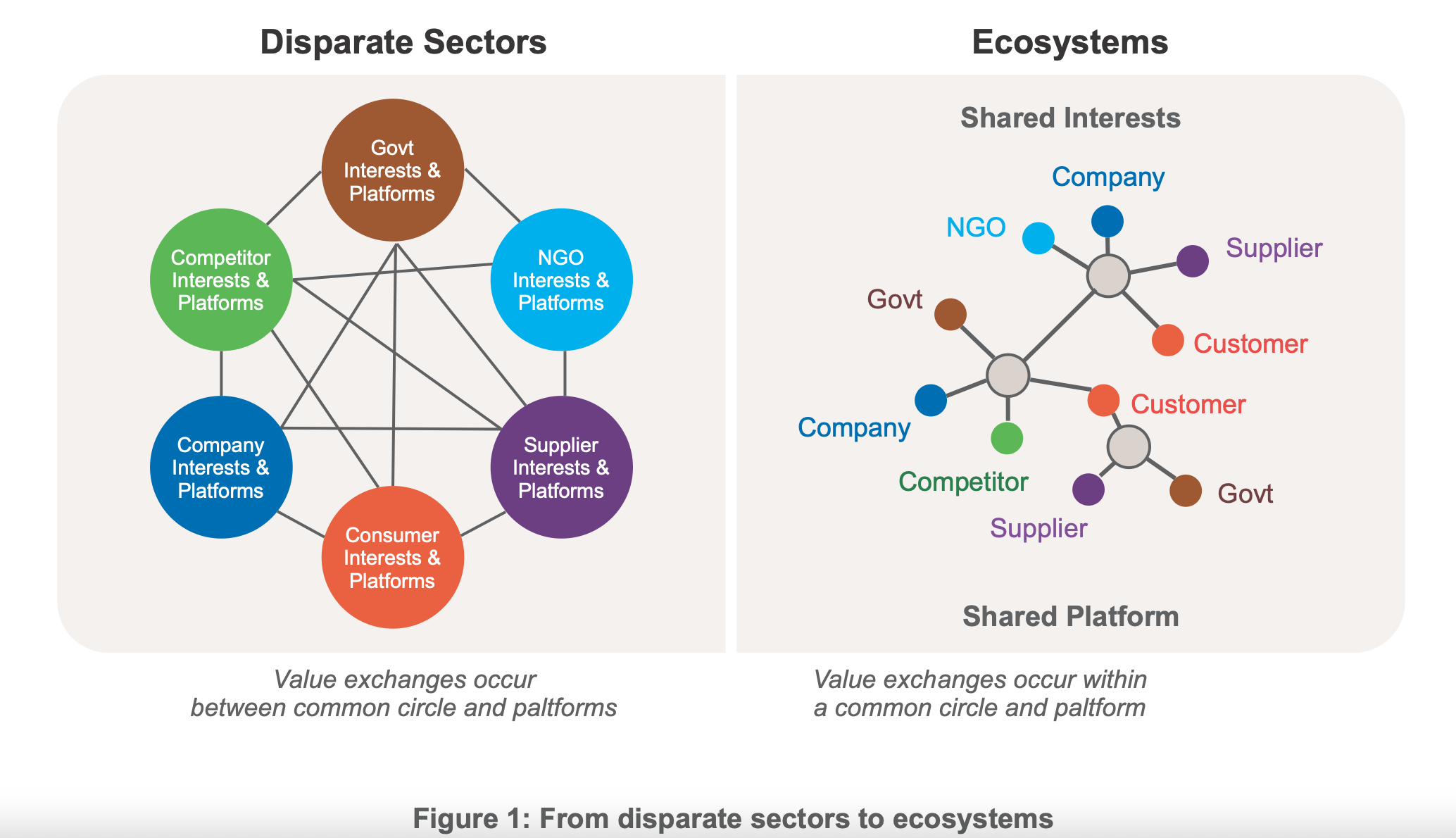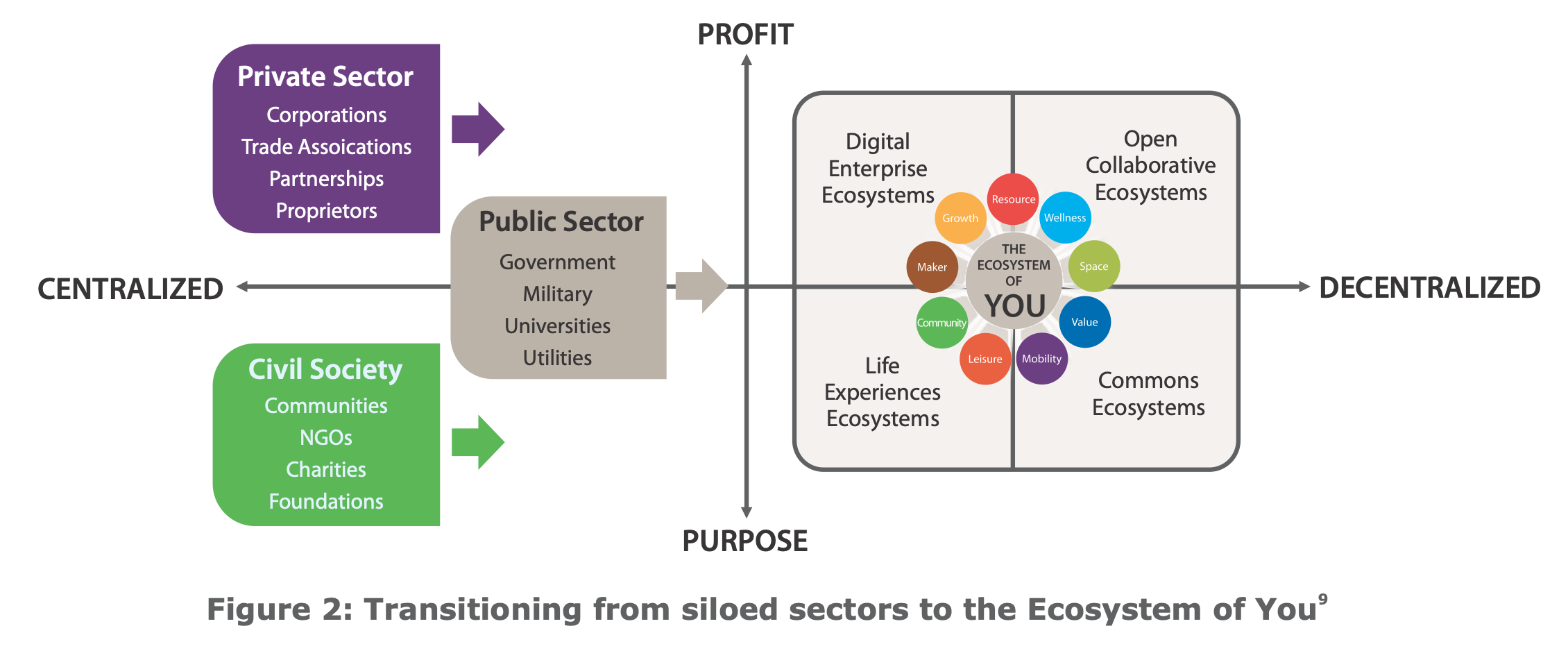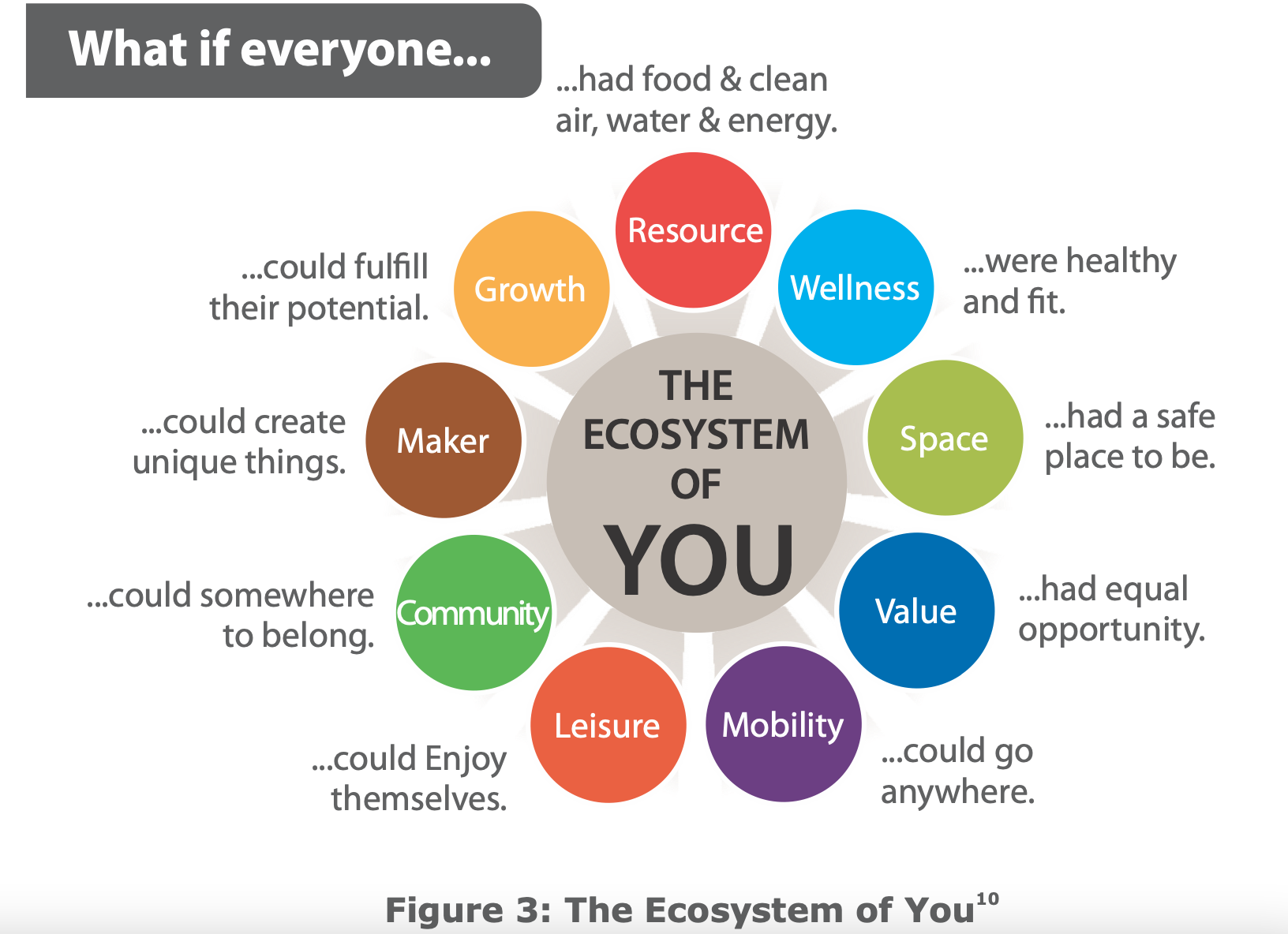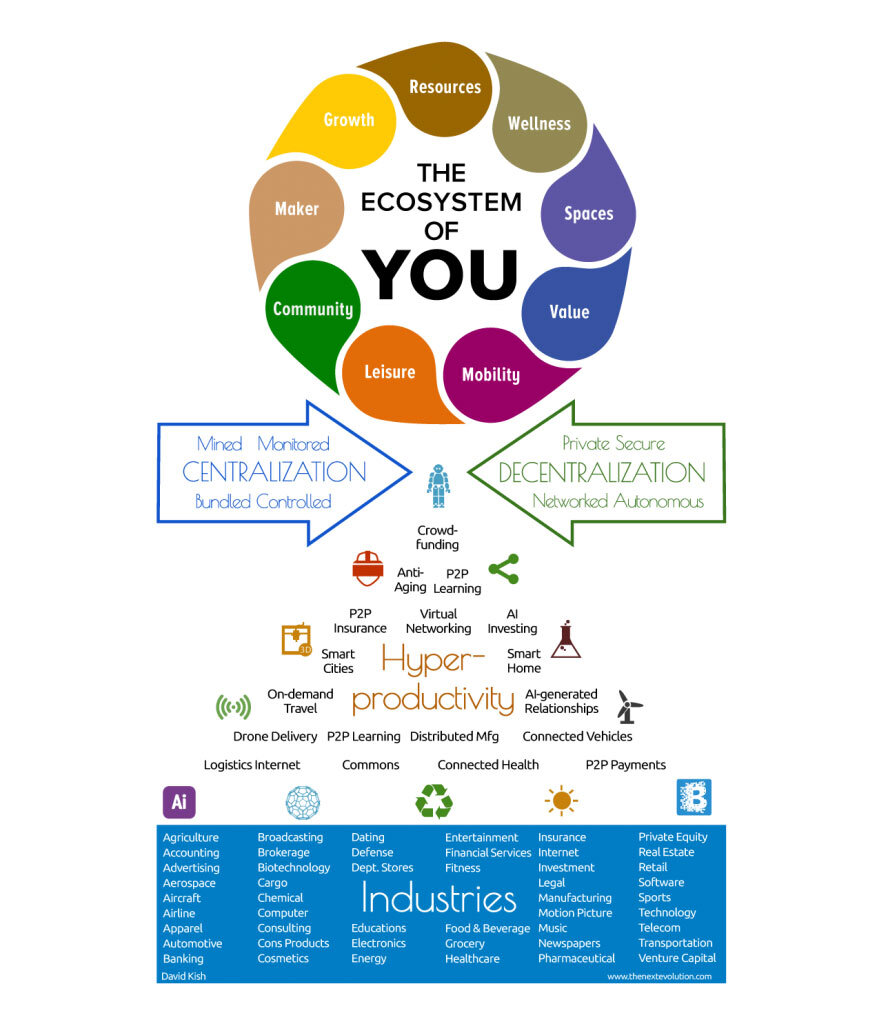We’ve swung towards (and away) from decentralisation for 50,000 years, says blockchainer Danielle Stanko. Her “Ecosystem of You” is a vision for the next swing
Danielle Stanko, from her interview in Women of Blockchain
We remain interested in blockchain technology - particularly so, now that it’s addressing its terrible record on energy use (which generates very weird news stories like this).
But it’s mainly because blockchain hints at a working digital infrastructure that doesn’t depend on the state, and which potentially exists in common with others (see this post from here previously, and this new paper on blockchain and the commons). It proceeds with the spirit of decentralisation, which fits with our own interest in cosmo-localisation.
So we were very interested to find the work of Danielle Stanko. In 2018, she wrote a piece titled “Decentralisation - We’ve Been Here Before”. Daniele went back into history, and tried to identify waves of decentralisation, centralisation, then the reverse - putting blockchain in a very deep context.
Some extracts below:
Blockchain seems to draw attention from three crowds. Those interested in cryptocurrency as an investment, those interested in industry applications, and those interested in decentralization.
Decentralization enthusiasts see blockchain as a way to fundamentally change society, taking it where it has never been before. However, it has.
70,000 years ago, society was decentralized to the point of little or no coordination between groups. From that point of uncoordinated hunter-gatherer society, humans did the exact opposite of what many blockchainers are hopeful for, and became centralized over time.
The same happened with the internet, initially a decentralized technology. The same types of problems that early humans faced also confronted internet users, who also solved them with centralization.
For people interested in the promise of decentralization, these repeated problems are worth noting. They apparently need to be solved.
With blockchain, we have the opportunity to take note, with the last 50 years of internet innovation as a fresh reminder, and consciously solve these problems in a decentralized way to break the centralization cycle. This could create the equality, trust, and transparency that many are hopeful for.
Humanity’s Centralization Cycle
The first cycle revolved around social organization of the physical world, and began about 70,000 years ago at the point of extreme decentralization. It marks the global migration, where people spread beyond Africa, presumably in search of richer resources and to avoid competition in densely populated areas. After that point, there are four major milestones that moved us toward our more centralized, modern civilization.
50,000 years ago: Humans use language to communicate
Specific Problem Solved: Inability to understand each other in complex ways.
General Problem Solved: Communication standards
Background: Language centralized the means of communication by transforming ad-hoc efforts that varied with each interaction to a set of communication patterns that allowed humans to plan and make collective decisions.
Language enabled groups to decide when to move and in what direction, acting as a key driver of migration to continents beyond those neighboring Africa.
Modern Lessons Learned: Blockchain standards and/or interoperability will be crucial.
The need for standards is well recognized and in progress within the blockchain community, but they are not yet solidified.
This makes it challenging to predict the best strategy for development, or to leverage work from other projects, inhibiting the reusability of existing components.
10,000 years ago: The invention of agriculture
Specific Problem Solved: Uncertainty and energy expended on hunting and gathering food.
General Problem Solved: Consolidated access to resources
Background: The invention of agriculture included domesticating animals, creating fenced grazing, and cultivating crops. This was the age of subsistence farming. Food could now be found in a predictable place and in greater amounts.
This generally improved well-being and prosperity. Humans no longer had to focus all of their their energy on securing food, which provided opportunities to develop new skills and improve living conditions.
Modern Lessons Learned: Before agriculture, resources had to be painstakingly hunted and gathered. After centralizing and corralling resources together, more energy could be expended on higher level needs.
The situation is similar with information. While it can sound great to decentralize its control for censorship resistance or security, there still needs to be a central point to collect it.
Right now, without block explorer programs, information about the blockchain requires a lot of effort to understand. Directories and listings of what and who is available within decentralized applications will be essential to connect parties together in digital, peer to peer environments.
The data stored on separate blockchains will need connection points so a user can access a holistic view of pertinent information in one place, like information regarding tokens, reputation, or ownership. If decentralized technology or organizations add extra steps and complexity for users, many will just opt for centralized solutions that more efficiently serve their needs.
5000 years ago: Marketplaces emerge for trade (cities and trading posts).
Specific Problem Solved: Manage the complexities of commerce
General Problem Solved: Marketplaces for exchange
Background: Agricultural innovations improved crop yields and reduced physical labor requirements, freeing individuals to pursue other activities like tool making and art to trade. Marketplaces connected people with excess food to those offering other goods or services.
However, in order to better facilitate trade between strangers, complex systems of social hierarchies were needed for rule-making and law enforcement. Later inventions like the printing press (550 yrs ago) spurred even greater levels of commerce by enabling merchants to document trade agreements and contracts.
Modern Lessons Learned: Governance, documentation, reciprocity, and rule enforcement are key for well functioning trade systems. Marketplaces for exchanging goods, information, or services need these defined structures so that people can determine whether or not to rely on them for making transactions. If these structures are not included in multi-party blockchain ecosystems, then those ecosystems will likely fail.
200 years ago: The steam engine, Industrial Revolution, and the shareholder model.
Specific Problem Solved: Large organizations with complex operations and high risk were difficult to undertake with a worker-owned business model.
General Problem Solved: Complex economic coordination: Reduce the amount of risk for many market participants. New products can be orchestrated and market participants can choose from a spectrum of risk/reward.
Background: The steam engine allowed humans to overcome their physical limitations and greatly improved labor productivity. Coal was the primary fuel of steam engines and therefore became a central part of the economy. Ultimately, a few large companies dominated and coordinated the coal industry, as the fuel was complex and expensive to extract.
Workers owning the tools for production was no longer feasible at scale. It was during this period that employers (rather than the workers) owned the tools to production. Similarly, stockholding was introduced where outside investors (rather than the business manager) owned shares in the company to offset the capital risk of complex production like coal mining, building railroads, producing oil, and mass production.
Under this model, the profile of business risk in the economy changed from small risks taken by many, toward very large risks taken by a few.
Modern Lessons Learned: Without this coordination between many people, resources, and investors, complex manufacturing and business processes would not exist in the market today.
Blockchain is a tool to create new types of markets, from cryptocurrencies to project work. So far, the markets are relatively simple. However, as the complexity of decentralized marketplace offerings increases, shared risk and coordination problems will need to be solved.
Decentralized insurance, initial coin offering (ICO) funding models, and attempts at decentralized autonomous organizations (DAOs) are just beginning, and will continue to emerge as economic activity on decentralized technologies increases.
The Internet and blockchain — repeating history?
The set of “General Problems Solved” from the age of resource coordination creates a pattern of four milestones, seen below on the social organization timeline.
There are four repeated problems that were solved by early humans, and then the internet. We are beginning to see these fundamental problems in blockchain development. The challenge will be to effectively solve them in decentralized ways.
With the problems generalized, repetition is easier to identify. The milestones align with those crossed by the internet (social organization of digital information, rather than physical resources). The internet was initially a decentralized group of computers, planting it on the far left side of the timeline to begin another journey.
To make the technology more useful, scientists, innovators and entrepreneurs made changes that increasingly centralized it over the course of 50 years. First, communication protocols were established, then ways to easily access and consolidate information with web browsers and search engines. The next step was to create marketplaces: eCommerce.
Once the ability to trade emerged, so ensued the consolidation of activities into increasingly complex organizations like Amazon and Google. And then in 2008, blockchain emerged at the far left of the timeline, this time as a technology for organizing value.
It is impossible to say the reasons driving its development; it could have been the need for new, better, or just different systems. However this time, as a decentralized technology emerges, many people carry first hand experience from the internet’s journey from decentralization to our existing circumstance: a few, powerful companies generating conveniences and wealth, but also inequality and lack of privacy.
It seems that the answer to a different future is in finding better solutions to the major milestones using decentralization, rather than centralization.
Decentralized solutions are already in progress among blockchain developers. Communication and protocol standards are being specified. People are crafting block explorer programs and blockchain browsers. Marketplaces are forming too, from cryptocurrency exchanges to general purpose marketplaces, even some that mimic eCommerce like Amazon or eBay.
Once market competition stabilizes, there will be opportunities to create complex organizations on top of them — we are just not there yet. Blockchain is still developing. Its mature state is unknown, but with awareness, passion, and some talented people, there is a chance that we could break the centralization cycle to create a new version of decentralized society. Decentralized society 3.0.
More here. Forward to 2021, and we find that Danielle is walking her talk, in terms of the better and wiser structures around blockchain that she advocated for. Her current project is “A New World of Ecosystems”, which sees blockchain as the link between 4 different ecosystems of change:
Digital Enterprise Ecosystems
Open Collaborative Ecosystems
Commons Ecosystems
Life Experience Ecosystems
This is how Danielle shows the difference between “the shift from value exchange between circles and platforms” to “value exchange within a common circle and platform”:
Below are some diagrams that hint at the bigger picture of how these ecosystems might hang together:
On the right hand quadrants above you can see the statement “an ecosystem of you” - an attempt to humanise these processes, guiding the interconnection of enterprises and initiatives to a human(e) end. Or in Danielle’s words,
As the industries of today transition toward hyper-connected ecosystems, there is a great opportunity to shift the perspective from ‘independently providing services to customers’ to ‘collaborating to enrich human lives’.
Finally, an intriguing model that shows how enterprises might think differently about innovation, in this entangled blockchain environment.
We recommend you read the papers linked to above. And of course, there is our old friend Vinay Gupta’s massive vision for blockchain as the basis for “lean green economy” (his latest articulation in 2021 below):






